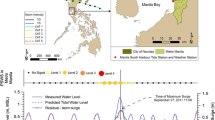Abstract
We developed the new typhoon bogussing scheme to obtain the possible maximum typhoon approaching any region under any climatic conditions by using a potential vorticity inversion method. Numerical simulations with the new typhoon bogussing scheme are conducted for assessment of storm surges by possible maximum typhoons under the present-day and global warming climatic conditions in Ise and Tokyo Bays in Japan. The results suggest that the storm tide higher than the maximum storm tide in recorded history can occur in Ise and Tokyo Bays even for the present-day climate and the storm tide higher than the design sea level can cause severe damage to Nagoya and Tokyo megacities, in particular, airport facilities in Ise Bay for the global warming climate. These results suggest that the new typhoon bogussing scheme we developed is useful for assessment of impacts of storm surge by the possible maximum typhoons.










Similar content being viewed by others
Notes
T.P.: Tokyo Peil, means sea level of Tokyo Bay, this is used as the standard of altitude in Japan.
References
Booij N, Holthuijsen LH, Ris RC (1996) The SWAN wave model for shallow water. Proc 25th Int Conf Coast Eng 1:668–676
Davidson NE, Wadsley J, Puri K, Kurihara K, Ueno M (1993) Implementation of the JMA typhoon bogus in the BMRC tropical prediction system. J Meteorol Soc Jpn 71:437–467
Dudhia JA (1993) Nonhydrostatic version of the Penn State-NCAR mesoscale model: validation test and simulation of an Atlantic cyclone and cold front. Mon Weather Rev 121:1493–1513
Emanuel KA (1987) The dependence of hurricane intensity on climate. Nature 326:483–485
Emanuel KA (1995) Sensitivity of tropical cyclones to surface exchange coefficients and a revised steady-state model incorporating eye dynamics. J Atmos Sci 52:3969–3976
Intergovernmental Panel on Climate Change (IPCC) (2007) The physical science basis, working group I contribution to the fourth assessment report of the intergovernmental panel on climate change. Cambridge University Press, Cambridge
Ishikawa H, Oku Y, Kim S, Takemi T, Yoshino J (2013) Estimation of a possible maximum flood event in the Tone River basin, Japan caused by a tropical cyclone. Hydrol Process. doi:10.1002/hyp.9830
Japan Meteorological Agency (JMA) (2005) Report for extreme weather (in Japanese). JMA
Kawasaki K, Ohashi S, Suzuki K, Murakami T, Shimokawa S, Yasuda T (2012) Numerical simulation of storm surge inundation around Tokyo port due to possible maximum typhoon under global warming (in Japanese). Ann J Civil Eng Ocean B3-68:852–857
Knutson TR, Sirutis JJ, Garner ST, Vecchi GA, Held IM (2008) Simulated reduction in Atlantic hurricane frequency under twenty-first-century warming conditions. Nat Geosci 1:359–364
McDonald RE, Bleaken DG, Cresswell DR, Pope VD, Senior CA (2005) Tropical storms: representation and diagnosis in climate models and impacts of climate change. Clim Dyn 25:19–36
Munich Re (2005) Topics Geo Annual review: natural catastrophes 2005. Munich Re
Murakami T, Yoshino J, Yasuda T (2008) A new simulation model of storm surges in Inland Sea affected by inflow from offshore and complicated winds. In: Proceedings of the 31st international conference on coastal engineering, pp 1147–1159
Murakami T, Yoshino J, Yasuda T, Iizuka S, Shimokawa S (2011) Atmosphere–ocean–wave coupled model performing 4DDA with a tropical cyclone bogussing scheme to calculate storm surges in an inner bay. Asian J Environ Disaster Manag 3:217–228
Oouchi K, Yoshimura J, Yoshimura H, Mizuta R, Kusunoki S, Noda A (2006) Tropical cyclone climatology in a global-warming climate as simulated in a 20-km-mesh global atmospheric model: frequency and intensity analysis. J Meteorol Soc Jpn 84:259–276
Science Council of Japan (SCJ) (2008) Toward sustainable association of nature and human in lands and ocean margins (in Japanese). SCJ
Ueno M (1989) Operational bogussing and numerical prediction of typhoon in JMA. JMA/NPD technical report no. 28, 48pp
Ueno M, Ohnogi K (1991) Changes in the preparing method of bogus typhoon. Summary report to WGNE meeting at NCAR, report no. 5, Boulder, CO, 13pp
United Nations Environment Programme (UNEP) (2007) Global Environment Outlook 4. UNEP
Yoshino J, Murakami T, Kobayashi K, Yasuda T (2008) An estimation method for potential maximum storm surge heights using a new tropical cyclone initialization scheme and a coupled atmosphere–ocean–wave model. Solut Coast Disasters Conf 2008:256–267
Acknowledgments
The authors would like to thank Dr. A. Ukai for useful comments and discussions. This research was supported by the Japan Society for the Promotion of Science through Grants Nos. 24360199 and 25400465, and by the National Research Institute for Earth Science and Disaster Prevention through a research project on the coastal disaster.
Author information
Authors and Affiliations
Corresponding author
Rights and permissions
About this article
Cite this article
Shimokawa, S., Murakami, T., Iizuka, S. et al. A new typhoon bogussing scheme to obtain the possible maximum typhoon and its application for assessment of impacts of the possible maximum storm surges in Ise and Tokyo Bays in Japan. Nat Hazards 74, 2037–2052 (2014). https://doi.org/10.1007/s11069-014-1277-2
Received:
Accepted:
Published:
Issue Date:
DOI: https://doi.org/10.1007/s11069-014-1277-2




